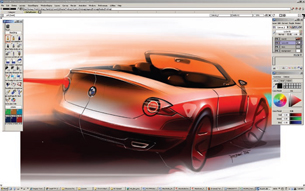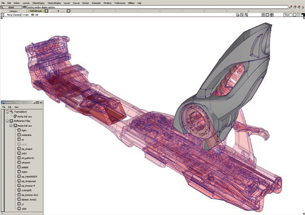Autodesk AliasStudio 2009 Nearly Does It All, 1 in a Series
This honest-to-gosh CAD program is also a professional sketching application as well as a photo-real renderer.
February 1, 2009
By Mark Clarkson
Page 1 | 2 »
 AliasStudio’s paint tools are great for early concept sketches of all sorts of products and foradding color and detail to 3D models when it’s time to make presentations. |
We look at the newest version of Autodesk’s AliasStudio and find little changed but still lots to like in this powerful and impressive application.
On a Scale of 1 to 10 …
I find myself regularly placing 3D applications on my personal CADishness scale — on the high end are the programs like Dassault’s CATIA; on my low end are programs like Autodesk’s Maya and Luxology’s modo. I think of the scale as running from CAD to “art,” from designs that are going straight to manufacturing, through to designs that are going straight to a glossy magazine ad.
AliasStudio is a tough one, though, as it does both. There’s no denying that it’s an honest-to-gosh “real” CAD program, but it’s also a professional sketching application and a photo-real renderer. You can sketch and paint; you can make beautiful, photo-real images and animations; but you can also, for example, create precise variable-radius fillets.
 You can load large datasets into AliasStudio as lightweight Reference Data, allowing you todesign in the context of a larger assembly without loading everything into memory at once. |
2D and the Other 2D
If you’re familiar with the 2D side of CAD, you’ll be right at home in AliasStudio 2009. You can create all the familiar CAD-style lines and curves and NURBS. It’s AliasStudio’s other 2D component that’s really remarkable.
Very similar to Autodesk’s SketchBookPro, AliasStudio’s ‘paint’ workspace is perfect for back-of-the-napkin concept sketches, and also for adding shading and detail to 3D objects by drawing on top of them. There are no palette knives or oil paints, but you will find pencils, markers, brushes, and paintbrushes. You can make basic adjustments to the default brush settings, varying the size, shape, softness, and opacity. AliasStudio’s predictive strokes make it easy to draw perfect arcs and lines, or turn predictive strokes off if your freehand skills are up to it.
Your sketches can be free and unconstrained, or you can draw on a 2D “canvas” plane, which can then be moved around in the 3D space.
AliasStudio’s sketching engine provides full pressure-sensitive tablet support although, for some reason, it only works in a dual monitor setup when the primary monitor is on the left. (Mine isn’t.) Hopefully, this will be fixed by the next iteration.
 AliasStudio’s software renderer produces very nice output, complete with depth offield and glowing surfaces. |
Digital Design
For 3D, AliasStudio creates surfaces rather than parametric solids. You create new surfaces from simple primitives, by extending or revolving 2D or 3D lines and curves, by creating patches across profile curves, and so on. You’ll also find all the requisite fillets, blends, rounds, and miters to join your surfaces together. AliasStudio 2009’s surfaces are robust and precise.
You can easily bend and twist finished meshes, and conform them to one another — to fit a logo onto a computer case or a badge onto a car hood, for example.
AliasStudio maintains a construction history of sorts, but it is more similar to 3ds Max’s than to the fully and forever editable form found in today’s parametric CAD modelers.
This version of the program improves the object lister, making it easier to organize your complex scenes, and to find particular objects within them.
Page 1 | 2 »
Subscribe to our FREE magazine, FREE email newsletters or both!
About the Author
Mark ClarksonContributing Editor Mark Clarkson is Digital Engineering’s expert in visualization, computer animation, and graphics. His newest book is Photoshop Elements by Example. Visit him on the web at MarkClarkson.com or send e-mail about this article to [email protected].
Follow DE





